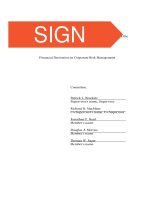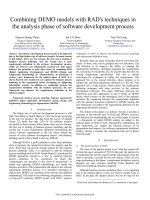Siumlation techniques in finacial risk management
Bạn đang xem bản rút gọn của tài liệu. Xem và tải ngay bản đầy đủ của tài liệu tại đây (2.91 MB, 228 trang )
SIMULATION
TECHNIQUES IN
FINANCIAL RISK
MANAGEMENT
Second Edition
WILEY SERIES IN STATISTICS IN PRACTICE
Advisory Editor, MARIAN SCOTT, University of Glasgow, Scotland, UK
Founding Editor, VIC BARNETT, Nottingham Trent University, UK
Statistics in Practice is an important international series of texts which provide
detailed coverage of statistical concepts, methods, and worked case studies in
specific fields of investigation and study.
With sound motivation and many worked practical examples, the books
show in down-to-earth terms how to select and use an appropriate range of
statistical techniques in a particular practical field within each title’s special
topic area.
The books provide statistical support for professionals and research workers across a range of employment fields and research environments. Subject
areas covered include medicine and pharmaceutics; industry, finance, and
commerce; public services; the earth and environmental sciences, and so on.
The books also provide support to students studying statistical courses
applied to the above areas. The demand for graduates to be equipped for the
work environment has led to such courses becoming increasingly prevalent at
universities and colleges.
It is our aim to present judiciously chosen and well-written workbooks to
meet everyday practical needs. Feedback of views from readers will be most
valuable to monitor the success of this aim.
A complete list of titles in this series appears at the end of the volume.
SIMULATION
TECHNIQUES IN
FINANCIAL RISK
MANAGEMENT
Second Edition
NGAI HANG CHAN AND HOI YING WONG
The Chinese University of Hong Kong
Copyright © 2015 by John Wiley & Sons, Inc. All rights reserved
Published by John Wiley & Sons, Inc., Hoboken, New Jersey
Published simultaneously in Canada
No part of this publication may be reproduced, stored in a retrieval system, or transmitted in any form or
by any means, electronic, mechanical, photocopying, recording, scanning, or otherwise, except as
permitted under Section 107 or 108 of the 1976 United States Copyright Act, without either the prior
written permission of the Publisher, or authorization through payment of the appropriate per-copy fee to
the Copyright Clearance Center, Inc., 222 Rosewood Drive, Danvers, MA 01923, (978) 750-8400, fax
(978) 750-4470, or on the web at www.copyright.com. Requests to the Publisher for permission should
be addressed to the Permissions Department, John Wiley & Sons, Inc., 111 River Street, Hoboken, NJ
07030, (201) 748-6011, fax (201) 748-6008, or online at />Limit of Liability/Disclaimer of Warranty: While the publisher and author have used their best efforts in
preparing this book, they make no representations or warranties with respect to the accuracy or
completeness of the contents of this book and specifically disclaim any implied warranties of
merchantability or fitness for a particular purpose. No warranty may be created or extended by sales
representatives or written sales materials. The advice and strategies contained herein may not be suitable
for your situation. You should consult with a professional where appropriate. Neither the publisher nor
author shall be liable for any loss of profit or any other commercial damages, including but not limited to
special, incidental, consequential, or other damages.
For general information on our other products and services or for technical support, please contact our
Customer Care Department within the United States at (800) 762-2974, outside the United States at
(317) 572-3993 or fax (317) 572-4002.
Wiley also publishes its books in a variety of electronic formats. Some content that appears in print may
not be available in electronic formats. For more information about Wiley products, visit our web site at
www.wiley.com.
Library of Congress Cataloging-in-Publication Data:
Chan, Ngai Hang.
Simulation techniques in financial risk management / Ngai Hang Chan and Hoi Ying Wong. – Second
edition.
pages cm. – (Statistics in practice)
Includes bibliographical references and index.
ISBN 978-1-118-73581-7 (hardback)
1. Finance–Simulation methods. 2. Risk management–Simulation methods. I. Wong, Hoi Ying,
1974- II. Title.
HG173.C47 2015
338.5–dc23
2015001921
Cover image courtesy of iStockphoto © pawel.gaul
Typeset in 10/12pt TimesLTStd by Laserwords Private Limited, Chennai, India
Printed in the United States of America
10 9 8 7 6 5 4 3 2 1
2 2015
To our families
N.H. Chan and H.Y. Wong
CONTENTS
List of Figures
xi
List of Tables
xiii
Preface
xv
1 Preliminaries of VBA
1.1
1.2
1.3
Introduction, 1
Basis Excel VBA, 1
1.2.1 Developer Mode and Security Level, 2
1.2.2 Visual Basic Editor, 2
1.2.3 The Macro Recorder, 5
1.2.4 Setting Up a Command Button, 6
VBA Programming Fundamentals, 8
1.3.1 Declaration of Variables, 8
1.3.2 Types of Variables, 8
1.3.3 Declaration of Multivariable, 9
1.3.4 Declaration of Constants, 9
1.3.5 Operators, 9
1.3.6 User-Defined Data Types, 10
1.3.7 Arrays and Matrices, 11
1.3.8 Data Input and Output, 12
1.3.9 Conditional Statements, 12
1.3.10 Loops, 13
1
viii
CONTENTS
1.3.11 Sub Procedures and Function Procedures, 15
1.3.12 VBA’s Built-In Functions, 18
2 Basic Properties of Futures and Options
2.1
2.2
2.3
Introduction, 19
2.1.1 Arbitrage and Hedging, 19
2.1.2 Forward Contracts, 20
2.1.3 Futures Contracts, 23
Options, 26
Exercises, 31
3 Introduction to Simulation
3.1
3.2
3.3
3.4
3.5
57
Introduction, 57
One Period Binomial Model, 58
The Black–Scholes–Merton Equation, 61
Black–Scholes Formula, 67
Exercises, 72
6 Generating Random Variables
6.1
6.2
6.3
6.4
6.5
41
Introduction, 41
Wiener and Itô’s Processes, 41
Stock Price, 46
Itô’s Formula, 47
Exercises, 54
5 Black–Scholes Model and Option Pricing
5.1
5.2
5.3
5.4
5.5
35
Questions, 35
Simulation, 35
Examples, 36
3.3.1 Quadrature, 36
3.3.2 Monte Carlo, 37
Stochastic Simulations, 38
Exercises, 40
4 Brownian Motions and Itô’s Rule
4.1
4.2
4.3
4.4
4.5
19
Introduction, 75
Random Numbers, 75
Discrete Random Variables, 76
Acceptance-Rejection Method, 78
Continuous Random Variables, 79
6.5.1 Inverse Transform, 80
75
ix
CONTENTS
6.6
6.5.2 The Rejection Method, 81
6.5.3 Multivariate Normal, 83
Exercises, 87
7 Standard Simulations in Risk Management
7.1
7.2
7.3
7.4
7.5
Introduction, 89
Scenario Analysis, 89
7.2.1 Value at Risk, 91
7.2.2 Heavy-Tailed Distribution, 92
7.2.3 Case Study: VaR of Dow Jones, 94
Standard Monte Carlo, 96
7.3.1 Mean, Variance, and Interval Estimation, 97
7.3.2 Simulating Option Prices, 99
7.3.3 Simulating Option Delta, 102
Exercises, 104
Appendix, 105
8 Variance Reduction Techniques
8.1
8.2
8.3
8.4
8.5
8.6
9.6
9.7
10
107
Introduction, 107
Antithetic Variables, 107
Stratified Sampling, 112
Control Variates, 120
Importance Sampling, 125
Exercises, 131
9 Path Dependent Options
9.1
9.2
9.3
9.4
9.5
89
133
Introduction, 133
Barrier Option, 133
Lookback Option, 135
Asian Option, 136
American Option, 138
9.5.1 Simulation: Least Squares Approach, 138
9.5.2 Analyzing the Least Squares Approach, 141
9.5.3 American Style Path Dependent Options, 144
Greek Letters, 145
Exercises, 148
Multiasset Options
10.1 Introduction, 151
10.2 Simulating European Multiasset Options, 152
10.3 Case Study: On Estimating Basket Options, 153
151
x
CONTENTS
10.4 Dimension Reduction, 155
10.5 Exercises, 158
11 Interest Rate Models
11.1
11.2
11.3
11.4
11.5
11.6
161
Introduction, 161
Discount Factor and Bond Prices, 161
Stochastic Interest Rate Models and Their Simulations, 165
Hull–White Model, 167
Fixed Income Derivatives Pricing, 171
Exercises, 174
12 Markov Chain Monte Carlo Methods
177
12.1
12.2
12.3
12.4
Introduction, 177
Bayesian Inference, 177
Simulating Posteriors, 179
Markov Chain Monte Carlo, 180
12.4.1 Gibbs Sampling, 180
12.4.2 Case Study: The Effect of Jumps on Dow Jones, 183
12.5 Metropolis–Hastings Algorithm, 188
12.6 Exercises, 196
References
199
Index
203
LIST OF FIGURES
1.1
Excel [Options]
2
1.2
Developer mode selection
3
1.3
Excel in developer mode
3
1.4
Macro security
4
1.5
Visual basic editor
4
1.6
The macro recorder
5
1.7
The recorded codes
6
1.8
Creating command button
7
1.9
Assigning a macro to a command button
7
2.1
Payoffs of option positions
2.2
The prices of Hang Seng Index options on September 12, 2014
26
30
e0.5
Densities of a lognormal distribution with mean
and variance
e(e − 1), that is, 𝜇 = 0 and 𝜎 2 = 1 and a standard normal distribution
39
Sample paths of the process S[nt] for different n and the same sequence
of 𝜖i
43
4.2
Sample paths of Brownian motions on [0,1]
44
4.3
Geometric Brownian motion
47
5.1
One period binomial tree
58
6.1
Sample paths of the portfolio
86
6.2
Sample paths of the assets and the portfolio
86
3.1
4.1
xii
LIST OF FIGURES
7.1
7.2
The shape of GED density function
Left tail of GED
93
93
7.3
7.4
7.5
QQ plot of normal quantiles against daily Dow Jones returns
Determine the maximum of 2f (y)ey graphically
QQ plot GED(1.21) quantiles against Dow Jones return quantiles
95
95
96
7.6
7.7
8.1
8.2
102
105
113
9.1
Simulations of the call price against the size
The log likelihood against 𝜉
Illustration of payoffs for antithetic comparisons
Payoff on a straddle as a function of input normal Z based
on the parameters S0 = K = 50, 𝜎 = 0.30, T = 1, and r = 0.05
Simulations of 500 standard normal random numbers by standard
Monte Carlo
Simulations of 500 standard normal random numbers by stratified
sampling
The exercising region of the American put option
9.2
9.3
Exercise regions of the American style Asian option
The strike against the delta of a down-and-out call option
146
147
8.3
8.4
114
117
117
144
10.1 The distribution of simulated price
10.2 The historical price of shocks
153
154
10.3 Simulating terminal asset prices
11.1 Cash flow of a 3-year coupon bond
155
162
11.2 Yield to maturity R(0, T)
11.3 Discount curve P(0, T)
164
165
11.4 Simulated sample path of xt
169
170
170
11.5 𝛼(t)
11.6 rt
12.1 A sample path of the jump-diffusion model
184
LIST OF TABLES
1.1
Numeric Data Type
1.2
VBA Logical Operators
1.3
Common Built-In Math Functions in VBA
18
2.1
Strategy A for Longing Futures Contracts
24
2.2
Data on Stock and Futures Prices
25
2.3
Payoffs of Different Options with Strike Price K
27
2.4
Payoffs of Portfolios A and B
28
2.5
Payoffs of Portfolios C and D
28
2.6
Payoffs of Portfolios E and F
31
2.7
Properties of Stock Options
31
7.1
Sales Record
90
7.2
Probability Mass Function
90
7.3
Policy Simulation and Evaluation
90
7.4
Simulated Prices of the First and the Last 10 Weeks
100
7.5
The Discounted Call Prices for the First 20 Paths
101
8.1
Effects of Stratification for Simulated Option Prices
with Different Bin Sizes
118
Effects of Stratification for Simulated Option Prices
with Restricted Normal
120
Sample Paths
139
8.2
9.1
9
10
xiv
LIST OF TABLES
9.2
9.3
Regression at t = 2∕3
Optimal Decision at t = 2∕3
139
140
9.4
9.5
Regression at t = 1∕3
Optimal Decision at t = 1∕3
140
141
12.1 Conjugate Priors
12.2 Performance of the Gibbs Sampling
179
187
12.3 Jump-Diffusion Estimation for Dow Jones
188
PREFACE
PREFACE TO THE SECOND EDITION
This book has now been in print for almost 10 years and has seen several printings.
During this period, the field of quantitative finance has experienced abrupt changes,
some for better and some for worse. But it has been very gratifying to us to have
heard from many readers that this book has been helpful to them in dealing with the
ever-changing financial landscape. It appears that to some extent at least the original
objectives set out in the first edition have been realized. This book can be used either
as an introductory text to simulations at the senior undergraduate or as a Master’s
level course. It can also be used as a complimentary source to the more specialized
treatise by Chan and Wong (2013) entitled Handbook of Financial Risk Management:
Simulations and Case Studies.
This second edition has been thoroughly revised and enhanced. Many of these
changes were results of teaching different courses in simulation for financial risk
managers over the years. In addition to cleaning up as many errors and misprints as
possible, the following specific changes have been incorporated in this revision.
• Many readers suggested more exercises with worked solutions. As a result, we
enlarge the problems and answers section in light of these requests.
• Because the use of VBA in Excel has been common in the financial industry, the
current edition incorporates this suggestion. We have now replaced all S-Plus
codes with VBA codes.
• Due to the advent in IT technology, a new website has been set up for readers
to download the VBA computer codes.
/>
xvi
PREFACE
•
•
•
•
As long as the website is available, we no longer print computer codes, so that
more space can be used for expanded topics.
Likewise, suggested solutions to exercises at the end of each chapter are now
available via online supplementary materials.
To make the book self-contained, two new chapters, Chapters 1 and 2, have
been added. Chapter 1 introduces basic concepts of Excel VBA, and Chapter 2
introduces basic concepts of derivatives.
Corresponding to Chapter 9 in the first edition, Chapter 11 of this edition is
expanded to discuss in detail a one-factor interest rate model and the calibration
to yield curves.
More examples have been added to illustrate the concept of MCMC, in particular the Metropolis–Hastings algorithm.
Finally, we would like to thank colleagues and students alike, who have been giving us suggestions and ideas throughout the years. In particular, we would like to
thank the editorial assistance of Dr. Warwick Yuen and Mr. Tom Ng of CUHK and
Ms. Sari Friedman and Mr. Jon Gurstelle of Wiley. We also want to express our gratitude to the Research Grants Council of HKSAR for support at various stages of our
work on this revision.
Ngai Hang Chan and Hoi Ying Wong
Shatin, Hong Kong
PREFACE
xvii
PREFACE TO THE FIRST EDITION
Risk management is an important subject in finance. Despite its popularity, risk management has a broad and diverse definition that varies from individual to individual.
One fact remains, however. Every modern risk management method comprises a
significant amount of computations. To assess the success of a risk management
procedure, one has to rely heavily on simulation methods. A typical example is the
pricing and hedging of exotic options in the derivative market. These over-the-counter
options experience very thin trading volume, and yet their nonlinear features forbid
the use of analytical techniques. As a result, one has to rely on simulations in order
to examine their properties. It is therefore not surprising that simulation has become
an indispensable tool in the financial and risk management industry today.
Although simulation as a subject has a long history by itself, the same cannot be
said about risk management. To fully appreciate the power and usefulness of risk
management, one has to acquire a considerable amount of background knowledge
across several disciplines: finance, statistics, mathematics, and computer science. It
is the synergy of various concepts across these different fields that marks the success
of modern risk management. Although many excellent books have been written on
the subject of simulation, none has been written from a risk management perspective.
It is therefore timely and important to have a text that readily introduces the modern
techniques of simulation and risk management to the financial world.
This text aims at introducing simulation techniques for practitioners in the financial and risk management industry at an intermediate level. The only prerequisite is
a standard undergraduate course in probability at the level of Hogg and Tanis (2006),
say, and some rudimentary exposure to finance. The present volume stems from a
set of lecture notes used at the Chinese University of Hong Kong. It aims at striking a balance between theory and applications of risk management and simulations,
particularly along the financial sector. The book comprises three parts.
• Part one consists of the first three chapters. After introducing the motivations
of simulation in Chapter 1, basic ideas of Wiener processes and Itô’s calculus
are introduced in Chapters 2 and 3. The reason for this inclusion is that many
students have experienced difficulties in this area because they lack the understanding of the theoretical underpinnings of these topics. We try to introduce
these topics at an operational level so that readers can immediately appreciate
the complexity and importance of stochastic calculus and its relationship with
simulations. This will pave the way for a smooth transition to option pricing and
Greeks in later chapters. For readers familiar with these topics, this part can be
used as a review.
• Chapters 4–6 comprise the second part of the book. This part constitutes the
main core of an introductory course in risk management. It covers standard topics in a traditional course in simulation, but at a much higher and succinct level.
Technical details are left in the references, but important ideas are explained in
a conceptual manner. Examples are also given throughout to illustrate the use of
these techniques in risk management. By introducing simulations this way, both
students with strong theoretical background and students with strong practical
motivations get excited about the subject early on.
xviii
PREFACE
• The remaining Chapters 7–10 constitute part 3 of the book. In this part, more
advanced and exotic topics of simulations in financial engineering and risk management are introduced. One distinctive feature in these chapters is the inclusion
of case studies. Many of these cases have strong practical bearings such as pricing of exotic options, simulations of Greeks in hedging, and the use of Bayesian
ideas to assess the impact of jumps. By means of these examples, it is hoped that
readers can acquire a first-hand knowledge about the importance of simulations
and apply them to their work.
Throughout the book, examples from finance and risk management have been
incorporated as much as possible. This is done throughout the text, starting at the
early chapter that discusses VaR of Dow to pricing of basket options in a multiasset
setting. Almost all of the examples and cases are illustrated with Splus and some with
Visual Basics. Readers would be able to reproduce the analysis and learn about either
Splus or Visual Basics by replicating some of the empirical work.
Many recent developments in both simulations and risk management, such as
Gibbs sampling, the use of heavy-tailed distributions in VaR calculation, and principal components in multiasset settings are discussed and illustrated in detail. Although
many of these developments have found applications in the academic literature, they
are less understood among practitioners. Inclusion of these topics narrows the gap
between academic developments and practical applications.
In summary, this text fills a vacuum in the market of simulations and risk management. By giving both conceptual and practical illustrations, this text not only provides
an efficient vehicle for practitioners to apply simulation techniques, but also demonstrates a synergy of these techniques. The examples and discussions in later chapters
make recent developments in simulations and risk management more accessible to a
larger audience.
Several versions of these lecture notes have been used in a simulation course given
at the Chinese University of Hong Kong. We are grateful for many suggestions, comments, and questions from both students and colleagues. In particular, the first author
is indebted to Professor John Lehoczky at Carnegie Mellon University, from whom
he learned the essence of simulations in computational finance. Part 2 of this book
reflects many of the ideas of John and is a reminiscence of his lecture notes at Carnegie
Mellon. We would also like to thank Yu-Fung Lam and Ka-Yung Lau for their help in
carrying out some of the computational tasks in the examples and for producing the
figures in LaTeX, and to Mr. Steve Quigley and Ms. Susanne Steitz, both from Wiley,
for their patience and professional assistance in guiding the preparation and production of this book. Financial support from the Research Grant Council of Hong Kong
throughout this project is gratefully acknowledged. Last, but not least, we would like
to thank our families for their understanding and encouragement in writing this book.
Any remaining errors are, of course, our sole responsibility.
Ngai Hang Chan and Hoi Ying Wong
Shatin, Hong Kong
1
PRELIMINARIES OF VBA
1.1
INTRODUCTION
This chapter introduces the elementary programming skills in Visual Basic for Applications (VBA) that we use for numerical computation of the examples in the book.
Experienced readers can read this chapter as a quick review.
1.2
BASIS EXCEL VBA
Microsoft Excel is widely used in the financial industry for performing financial
calculations. VBA is a common programming language linked to Excel and other
Microsoft Office software that was developed to automatically control and perform
repetitive actions. In this section, we guide readers on how to start a VBA in Microsoft
Excel and give some popular algorithms for performing repetitions. In most cases,
simple algorithms will be sufficient to perform the computations in the examples and
exercises. We provide the illustrations in Excel 2010, although other versions can be
set up in a similar way. For a comprehensive reference, readers are referred to other
books.
Simulation Techniques in Financial Risk Management, Second Edition. Ngai Hang Chan and Hoi Ying Wong.
© 2015 John Wiley & Sons, Inc. Published 2015 by John Wiley & Sons, Inc.
2
PRELIMINARIES OF VBA
1.2.1
Developer Mode and Security Level
For first-time users of VBA in Excel, it is more convenient to switch on the developer mode, where many of the VBA functions can be easily accessed. To open the
developer mode, follow the following steps:
Click [File] → [Options] (Fig. 1.1) → [Customize Ribbon] (Fig. 1.2) →
[Developer].
Figure 1.3 shows the ribbons at the top of Excel after switching on the developer
mode. Macros refer to the codes executed in the VBA language. To execute the macros
promptly, users are recommended to turn down the security level as follows:
Click [Macro Security] (Fig. 1.3) → Macro Settings [Enable all macros] (Fig. 1.4).
1.2.2
Visual Basic Editor
To edit the VBA codes, Microsoft provides a Visual Basic editor (VBE) in Excel
for editing the macros. Macros are created, edited, and debugged in the VBE before
being executed. A macro is usually created as a Sub or Function procedure that can
perform automatic tasks, while a module consists of one or more macros. Similarly,
a project has one or more modules. Sub and Function are reserved keywords in VBA.
Users need to avoid using keywords when defining new variables. The codes in the
Figure 1.1
Excel [Options].
3
BASIS EXCEL VBA
Figure 1.2 Developer mode selection.
Figure 1.3
Excel in developer mode.
VBE are saved together with the Excel worksheet. In Excel 2010, these worksheets
can be saved as .xlsm as an Excel Macro-Enabled Workbook file. To open and edit
macros in VBE, follow the following procedure:
1. Open VBE: click the [Visual Basic] button under the developer mode (Fig. 1.3)
or press ALT+F11.
2. Insert module: in the project window of the VBE, right-click on one of the
worksheets, and select [Insert] → [Module] (Fig. 1.5).
3. Edit in VBE: type the codes in the panel on the right.
4
PRELIMINARIES OF VBA
Figure 1.4
Figure 1.5
Macro security.
Visual basic editor.
5
BASIS EXCEL VBA
4. Execute the program: in the VBE, select the module, and click the “Play” ribbon
or press F5. In the Excel worksheet (Fig. 1.3), click the [Macros] button, choose
the macro to be run, and click [Run]. A command button for a specific macro
can be inserted in the Excel worksheet to facilitate the execution. See Section
1.2.4 for details.
1.2.3
The Macro Recorder
The macro recorder can record the actions that you perform in the Excel worksheet,
such as building a chart or typing words, and transfer the actions into the macros in the
VBE. This will be useful when you do not know how to code the actions and need to
repeat them later. However, the macro recorder cannot handle codes that involve using
the For loop or other repetitive loops and assigning variables. Different environments
in Excel may generate different codes for the same task. Nevertheless, it can be a
handy tool for learning new VBA codes. To record a macro, do the following:
1. Open the macro recorder: in the developer mode (Fig. 1.3), click [Record
Macro].
2. Type the name to be used for the macro and a description of it so that you can
recognize the macro next time (Fig. 1.6), then click [OK]. Note that the name
should begin with a letter and contain no spaces or special characters.
3. Perform the tasks to be recorded; for example, type “Hello World” in cell A1.
4. Stop the macro recorder: click the [Stop Recording] button.
5. Go to the VBE to see the codes generated by the computer (Fig. 1.7).
Figure 1.6
The macro recorder.









